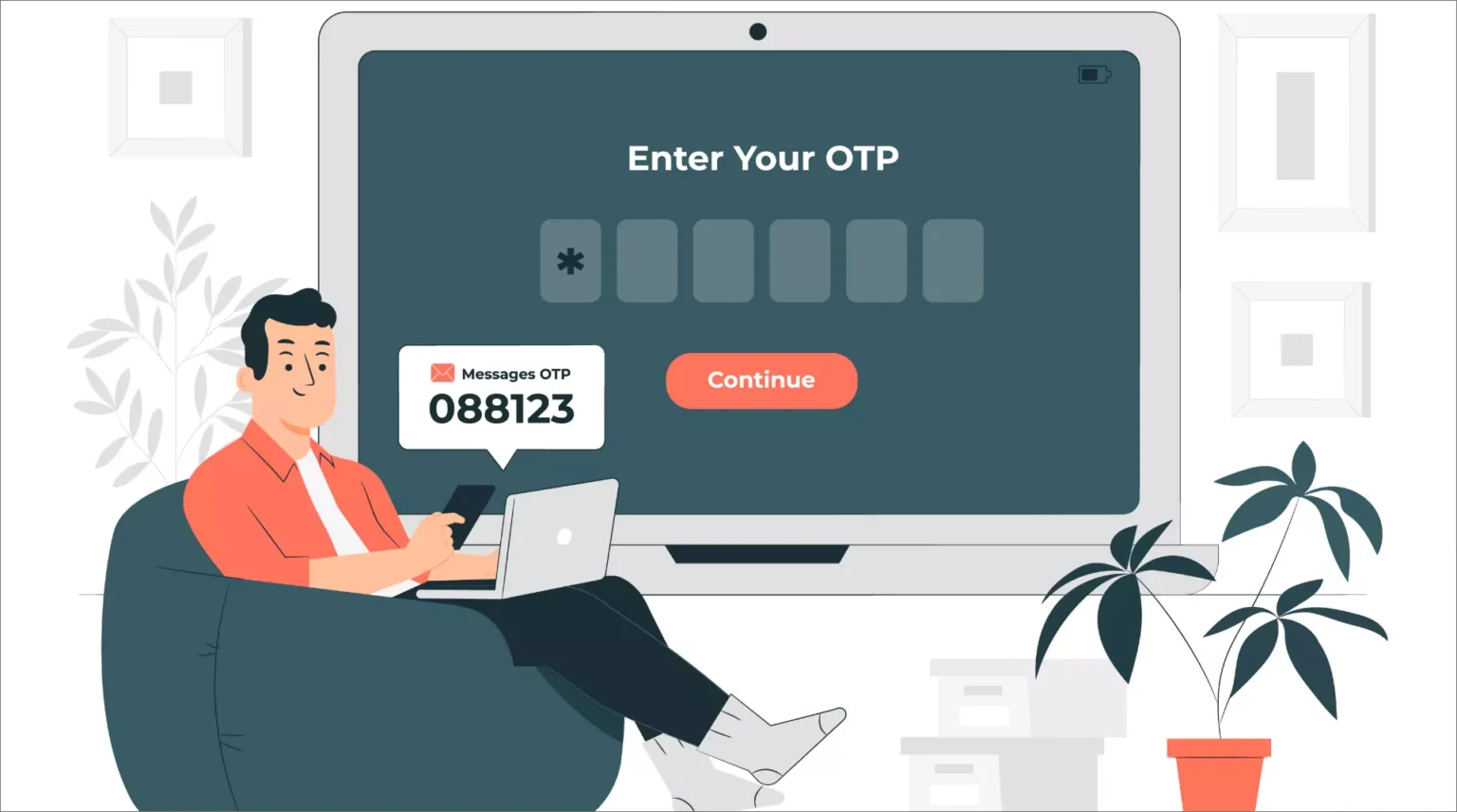Online security has become paramount in a world full of cyber crimes and fraud in business communication. The more we conduct our personal and business transactions over the Internet, the more the need for robust authentication methods increases.
One effective method that gained popularity is the One-Time Password (OTP). It offers a straightforward and cost-efficient method for organizations to verify and safeguard the personal information of their customers and employees.
If you want to explore ways to quickly authenticate your users globally while streamlining your organization’s operations and cutting costs, this guide is your go-to resource.
What Is a One-Time Password?
A One-Time Password (OTP) is a verification tool used to authenticate users when they log into an account, network, or system. This password consists of a unique string of numbers or letters that can only be utilized for a single login attempt. Whether they are used or not, OTPs have a limited lifespan and expire after a brief period.
True to their name, OTPs are single-use and have a predetermined expiration time. They can be delivered to users via various methods, including email, phone calls, authenticator apps (such as Google Authenticator or Microsoft Authenticator), text messages, or push notifications.
OTPs can serve as a form of single-factor authentication, replacing static passwords. Instead of creating a traditional username and password, customers are provided with a unique PIN for each session.
How Does One Time Password Work?
OTP systems rely on generating and verifying a unique code sent to the user through a secure channel.
Here’s a step-by-step breakdown of how OTPs work:
1. Request for Authentication
When a user attempts to log in to an account or perform a sensitive action, they are prompted to enter their username and, in some cases, their password.
2. OTP Generation
After the initial login credentials are entered, the system generates a unique OTP. This code is typically random and varies each time a user requests it.
3. Delivery Mechanisms
OTPs can be delivered to the user through various methods, including:
- SMS (Short Message Service): The OTP is sent to the user’s registered mobile phone number as a text message.
- Email: Some systems send OTPs to the user’s registered email address.
- Mobile Apps: Dedicated authentication apps like Google Authenticator or Authy generate OTPs directly on the user’s device.
- Hardware Tokens: In some cases, physical devices known as hardware tokens can generate OTPs.
4. User Input
The user receives the OTP and must input it into the system within a specified time frame.
5. Verification
The system compares the user-entered OTP with the OTP generated by the server. If these OTPs match, access is granted; otherwise, access is denied.
Key Features Of One-Time Passwords (OTPs)
Here are some key features of OTPs:
- Temporary: OTPs have a short lifespan, typically lasting only a few minutes or until they are used. This time constraint adds an extra layer of security because even if a malicious actor intercepts the OTP, it would likely be useless shortly.
- Dynamic: Each OTP is unique and cannot be predicted or reused. It makes it extremely difficult for attackers to gain unauthorized access to an account, even if they can access a user’s previous OTPs.
- Two-Factor Authentication (2FA): OTPs are often used as part of two-factor authentication (2FA) or multi-factor authentication (MFA) processes. In 2FA, users must provide something they know (e.g., a password) and something they have (e.g., an OTP) to gain access.
Benefits Of One-Time Passwords (OTPs)?
One-time passwords play a vital role in enhancing online security.
Let’s explore its benefits in detail:
i. Identify Thieves
Businesses employing OTPs for user authentication significantly enhance the security of their customer’s and employees’ accounts, making it substantially more challenging for unauthorized individuals to breach and steal personal data.
To illustrate, let’s envision a scenario where an unauthorized party attempts to gain access to someone else’s account. The legitimate account holder receives an unexpected verification code. It immediately raises suspicion.
While the organization may only speculate about the legitimacy of the login attempt, the user becomes instantly aware of suspicious activity and takes proactive measures to reinforce their account security, often by updating their password.
Additionally, verification messages can be dispatched to the user’s designated mobile number or email address whenever an unfamiliar or unregistered device attempts to access their account. Should the need arise, the account owner can swiftly flag any irregularities with a simple click.
Rather than automatically locking a user’s account at the slightest sign of suspicion, which could be excessively frustrating if the activity was legitimate, the user retains complete control. Moreover, these alert mechanisms signal to individuals that businesses are actively monitoring and safeguarding their personal information, thereby fostering trust and confidence in the organization.
ii. Reduce Burden From Your IT Support
We have all been there, juggling a multitude of usernames and passwords for various accounts. It is inevitable to forget at least one, whether for your streaming service, online newspaper subscriptions, or other platforms.
Forgetfulness is a common human trait. Without alternative verification methods, individuals often turn to their IT support or customer care teams for assistance in regaining access to their accounts. It may take a significant amount of time.
Here is where OTPs come into play, offering a more efficient approach to password resets and saving countless hours of valuable human resources. As a result:
- IT and customer support teams gain the opportunity to redirect their efforts towards more productive tasks and addressing critical business issues.
- Users benefit from a swifter and more convenient method for resetting their passwords and swiftly regaining access to their accounts.
iii. Highly Difficult To Guess
Despite their simplicity consisting of just four to eight random numbers – OTPs are remarkably effective in strengthening security, particularly when combating the vulnerabilities associated with weak password practices.
Let’s break this down mathematically:
When a random six-digit OTP is issued, an identity thief must correctly guess each digit within a relatively short expiration window. With only ten possibilities for each digit (ranging from zero to nine), this equates to ten choices for each of the six digits (10x10x10x10x10x10).
It means an identity thief faces a mere one in a million chance of correctly guessing your OTP, translating to a tiny probability of 0.000001%.
And that’s just for a standard six-digit OTP. If you were to employ an eight-digit OTP, the odds of success for a would-be identity thief would be even more akin to winning the lottery.
IV. Enhance User Experience
An organization’s reputation is tied to customers’ trust in their brand. Our research underscores this, revealing that 73% of consumers trust a brand when their personal information and accounts are secure.
No business desires the daunting task of informing customers that their data has fallen into the wrong hands, right?
It is where multi-factor authentication solutions, such as Sinch’s SMS Verification API, come into play. They offer security on a large scale while ensuring a seamless and user-friendly experience.
Easy To Integrate and Scale Up For Organizations
Organizations can seamlessly incorporate OTPs into their applications and products by leveraging verification APIs.
These programmable verification integrations can rapidly prove their worth by:
i. Mitigating Cybersecurity Risks
They act as a robust defense against internal and external cybersecurity threats. It includes thwarting unauthorized internal access risks and countering external threats posed by malicious actors attempting to gain access through unauthorized means or guessing a user’s standard login credentials.
ii. Enhancing Customer Trust
By adding a layer of security beyond conventional username and password credentials, these integrations reassure customers that their sensitive data remains shielded from unauthorized access.
This trust-building element is instrumental in maintaining a positive reputation and customer loyalty.
iii. Optimizing Human Resources
These integrations significantly reduce the necessity for manual verification and assistance, thus liberating valuable human support resources.
As a result, your workforce can redirect their efforts towards higher-level objectives and tasks, ultimately contributing to improved productivity and efficiency.
Are One-Time Passwords Secure?
As an identity verification method, passwords are vulnerable, with 74% of business data breaches in 2023 attributed to weaknesses like weak or stolen credentials. To enhance password security, businesses must educate customers on best practices, such as not sharing, using unique passwords, and avoiding personal information.
However, for sensitive data, an extra layer of security is essential. One-time passwords (OTPs) or two-factor authentication (2FA) are effective because they change for each login attempt, bolstering security significantly.
Still, OTPs can be vulnerable to abuse by hackers. Consider using SIM-based verification methods like Flash Call Verification and Data Verification to counter this. These methods require user engagement with prompts on their mobile devices, adding complexity for potential hackers.
Conclusion - One-Time Passwords (OTPs)
In a digital world fraught with cybersecurity threats and data breaches, the importance of robust authentication methods cannot be overstated. One-time passwords (OTPs) have emerged as a highly effective solution for enhancing online security. They offer a dynamic and versatile approach to safeguarding personal information, making them an invaluable asset for businesses and individuals.
By exploring the intricacies of OTPs, their workings, and their myriad benefits, this article has shed light on their pivotal role in protecting against password vulnerabilities, reducing the burden on IT support, and bolstering user trust. OTPs are highly secure, with minuscule probabilities of being guessed, and contribute to a streamlined and user-friendly experience.
To further enhance security, businesses can consider incorporating SIM-based verification methods like Flash Call Verification and Data Verification. These measures add a layer of complexity for potential hackers, safeguarding sensitive data and fostering trust in the digital landscape. In an era of ever-evolving cyber threats, OTPs, and advanced verification methods remain at the forefront of fortifying online security and protecting valuable personal and organizational information.
FAQs
OTPs enhance security by adding an extra layer of verification beyond traditional usernames and passwords, making it more difficult for unauthorized users to access accounts.
OTPs can be delivered via SMS, email, authenticator apps (like Google Authenticator), voice calls, or push notifications.
OTPs are generally considered secure due to their temporary and unique nature. However, their security can be compromised if not handled properly, such as through interception of SMS messages.
2FA combines something you know (like a password) with something you have (like an OTP). OTPs are often used as the second factor in 2FA to enhance security.
The validity of an OTP depends on the system or service provider, but it typically lasts for a few minutes to an hour. After the expiration time, the OTP becomes useless.
No, OTPs are designed for one-time use only. Once used, they cannot be used again for authentication.
If you receive an unexpected OTP, it is a sign of potentially unauthorized access. You should immediately change your password and notify the service provider.
If you enter an incorrect OTP, you will typically be denied access, and you may need to request a new OTP to try again. The number of allowed attempts varies by the service provider.




